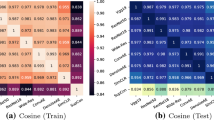Abstract
Extreme learning machine (ELM) is proposed for solving a single-layer feed-forward network (SLFN) with fast learning speed and has been confirmed to be effective and efficient for pattern classification and regression in different fields. ELM originally focuses on the supervised, semi-supervised, and unsupervised learning problems, but just in the single domain. To our best knowledge, ELM with cross-domain learning capability in subspace learning has not been exploited very well. Inspired by a cognitive-based extreme learning machine technique (Cognit Comput. 6:376–390, 1; Cognit Comput. 7:263–278, 2.), this paper proposes a unified subspace transfer framework called cross-domain extreme learning machine (CdELM), which aims at learning a common (shared) subspace across domains. Three merits of the proposed CdELM are included: (1) A cross-domain subspace shared by source and target domains is achieved based on domain adaptation; (2) ELM is well exploited in the cross-domain shared subspace learning framework, and a new perspective is brought for ELM theory in heterogeneous data analysis; (3) the proposed method is a subspace learning framework and can be combined with different classifiers in recognition phase, such as ELM, SVM, nearest neighbor, etc. Experiments on our electronic nose olfaction datasets demonstrate that the proposed CdELM method significantly outperforms other compared methods.






Similar content being viewed by others
References
Huang GB. An insight into extreme learning machines: random neurons, random features and kernels. Cognit Comput. 2014;6(3):376–90.
Huang GB. What are extreme learning machines? Filling the gap between frank Rosenblatt's dream and John von Neumann's puzzle. Cognit Comput. 2015;7(3):263–78.
Huang GB, Zhu QY, Siew CK. Extreme learning machine: theory and applications. Neurocomputing. 2006;70(1–3):489–501.
Huang GB, Zhou H, Ding X, Zhang R. Extreme learning machine for regression and multiclass classification. IEEE Trans Syst Man Cybern B Cybern. 2012;42(2):513–29.
Cambria E. Extreme learning machines [trends & controversies]. IEEE Intell Syst. 2013;28(6):30–59.
Huang GB, Chen L, Siew CK. Universal approximation using incremental constructive feedforward networks with random hidden nodes. IEEE Trans Neural Netw. 2006;17(4):879–92.
Huang GB, Zhu QY, Siew CK. Extreme learning machine: a new learning scheme of feedforward neural networks. In: Proc. IEEE Int Joint Conf Neural Netw. vol. 2. pp. 985–990, 2004.
Huang GB, Chen L. Convex incremental extreme learning machine. Neurocomputing. 2007;70(16–18):3056–62.
Huang GB, Chen L. Enhanced random search based incremental extreme learning machine. Neurocomputing. 2008;71(16–18):3460–8.
Rumelhart DE, Hinton GE, Williams RJ. Learning representations by back-propagation errors. Nature. 1986;323:533–6.
Huang GB, Zhu QY, Mao KZ, Siew CK, Saratchandran P. Can threshold networks be trained directly? IEEE Trans Circ Syst II Exp Briefs. 2006;53(3):187–91.
Liang NY, Huang GB, Saratchandran P, Sundararajan N. A fast and accurate on-line sequential learning algorithm for feedforward networks. IEEE Trans Neural Netw. 2006;17(6):1411–23.
Li MB, Huang GB, Saratchandran P, Sundararajan N. Fully complex extreme learning machine. Neurocomputing. 2005;68:306–14.
Feng G, Huang GB, Lin Q, Gay R. Error minimized extreme learning machine with growth of hidden nodes and incremental learning. IEEE Trans Neural Netw. 2009;20(8):1352–7.
Rong HJ, Huang GB, Sundararajan N, Saratchandran P. Online sequential fuzzy extreme learning machine for function approximation and classi fication problems. IEEE Trans Syst Man Cybern B Cybern. 2009;39(4):1067–72.
Huang Z, Yu Y, Gu J and Liu H. An efficient method for traffic sign recognition based on extreme learning machine. IEEE Trans Cybern, Appear Online, 2016.
Yu Y, Sun Z. Sparse coding extreme learning machine for classification. Neurocomputing, accepted, 2016.
Zhang L, Zhang D. Evolutionary cost-sensitive extreme learning machine. IEEE Trans Neural Netw Learn Syst. 2016; doi:10.1109/TNNLS.2016.2607757.
Zhang L, Zhang D. Robust Visual knowledge transfer via extreme learning machine based domain. IEEE Trans Image Process. 2016;25(10):4959–73.
Zong W, Huang GB, Chen Y. Weighted extreme learning machine for imbalance learning. Neurocomputing. 2013;101:229–42.
Bai Z, Huang GB, Wang D, Wang H, Westover MB. Sparse extreme learning machine for classification. IEEE Trans Cybern. 2014;44(10):1858–70.
Huang GB, Song S, Gupta JND, Wu C. Semi-supervised and unsupervised extreme learning machines. IEEE Trans. Cybern. 2014; doi:10.1109/TCYB.2014.2307349.
Liu H, Yu Y, Sun F, et al. Visual-tactile fusion for object recognition. IEEE Trans Autom Sci Eng. 2016;14:1–13.
Liu H, Guo D, Sun F. Object recognition using tactile measurements: kernel sparse coding methods. IEEE Trans Instrum Meas. 2016;65(3):1–10.
Liu H, Liu Y, Sun F. Robust exemplar extraction using structured sparse coding. IEEE Trans Neural Netw Learn Syst. 2014;26(8):1816–21.
Liu H, Qin J, Sun F, et al. Extreme kernel sparse learning for tactile object recognition. IEEE Trans Cyber, 2016.
Pan SJ, Tsang IW, Kwok JT, Yang Q. Domain adaptation via transfer component analysis. IEEE Trans Neural Netw. 2011;22(2):199–210.
Zhang L, Zuo W, Zhang D. LSDT: latent sparse domain transfer learning for Visual adaptation. IEEE Trans Image Process. 2016;25(3):1177–91.
Zhang L, Zhang D. Domain adaptation extreme learning machines for drift compensation in e-nose systems. IEEE Trans Instrum Meas. 2015;64(7):1790–801.
Turk M, Pentland A. Eigenfaces for recognition. J Cogn NeuroSci. 1991;3(1):71–86.
Belhumeur PN, Hespanha J, Kriegman DJ. Eigenfaces vs. fisherfaces: recognition using class specific linear projection. IEEE Trans Pattern Anal Mach Intell. 1997;19(7):711–20.
He X, Niyogi P. Locality preserving projections. NIPS, 2004.
Zhang L, Tian F. Performance study of multilayer Perceptrons in a low-cost electronic nose. IEEE Trans Instrum Meas. 2014;63(7):1670–9.
Torgerson WS. Multidimensional scaling: I. Theory and method. Psychometrika. 1952;17(4):401–19.
Goldberger J, Roweis S, Hinton G, Salakhutdinov R. Neighborhood component analysis. NIPS, 2004.
He X, Cai D, Yan S, and Zhang HJ. Neighborhood preserving embedding. ICCV, 2005.
Sugiyama M. Local fisher discriminant analysis for supervised dimensionality reduction. ICML, pp. 905–912, 2006.
Gopalan R, Li R, and Chellappa R. Domain adaptation for object recognition: an unsupervised approach. ICCV, 2011.
Acknowledgements
This work was supported by the National Natural Science Foundation of China under Grant 61401048, the Fundamental Research Funds for the Central Universities, and Chongqing University Postgraduates’ Innovation Project (No.CYB15030).
Author information
Authors and Affiliations
Corresponding author
Ethics declarations
Conflict of Interest
Yan Liu, Lei Zhang, Pingling Deng, and Zheng He declare that they have no conflict of interest.
Informed Consent
Informed consent was not required as no human or animals were involved.
Human and Animal Rights
This article does not contain any studies with human or animal subjects performed by any of the authors.
Rights and permissions
About this article
Cite this article
Liu, Y., Zhang, L., Deng, P. et al. Common Subspace Learning via Cross-Domain Extreme Learning Machine. Cogn Comput 9, 555–563 (2017). https://doi.org/10.1007/s12559-017-9473-5
Received:
Accepted:
Published:
Issue Date:
DOI: https://doi.org/10.1007/s12559-017-9473-5




